[English] 日本語
 Yorodumi
Yorodumi- PDB-2g2l: Crystal Structure of the Second PDZ Domain of SAP97 in Complex wi... -
+ Open data
Open data
- Basic information
Basic information
| Entry | Database: PDB / ID: 2g2l | ||||||
|---|---|---|---|---|---|---|---|
| Title | Crystal Structure of the Second PDZ Domain of SAP97 in Complex with a GluR-A C-terminal Peptide | ||||||
 Components Components |
| ||||||
 Keywords Keywords | MEMBRANE PROTEIN / synaptic signaling / trafficking protein | ||||||
| Function / homology |  Function and homology information Function and homology informationtissue morphogenesis / L27 domain binding / regulation of protein localization to synapse / regulation of potassium ion import / MPP7-DLG1-LIN7 complex / regulation of potassium ion export across plasma membrane / membrane raft organization / establishment of centrosome localization / hard palate development / structural constituent of postsynaptic density ...tissue morphogenesis / L27 domain binding / regulation of protein localization to synapse / regulation of potassium ion import / MPP7-DLG1-LIN7 complex / regulation of potassium ion export across plasma membrane / membrane raft organization / establishment of centrosome localization / hard palate development / structural constituent of postsynaptic density / membrane repolarization during ventricular cardiac muscle cell action potential / astral microtubule organization / embryonic skeletal system morphogenesis / negative regulation of p38MAPK cascade / epithelial structure maintenance / reproductive structure development / immunological synapse formation / lateral loop / receptor localization to synapse / myelin sheath abaxonal region / peristalsis / smooth muscle tissue development / bicellular tight junction assembly / cortical microtubule organization / cell projection membrane / paranode region of axon / Trafficking of AMPA receptors / protein localization to synapse / establishment or maintenance of epithelial cell apical/basal polarity / Activation of Ca-permeable Kainate Receptor / regulation of ventricular cardiac muscle cell action potential / positive regulation of potassium ion transport / protein-containing complex localization / node of Ranvier / amyloid precursor protein metabolic process / endothelial cell proliferation / Synaptic adhesion-like molecules / RAF/MAP kinase cascade / cortical actin cytoskeleton organization / lens development in camera-type eye / regulation of myelination / ureteric bud development / neurotransmitter receptor localization to postsynaptic specialization membrane / ligand-gated monoatomic ion channel activity / branching involved in ureteric bud morphogenesis / positive regulation of actin filament polymerization / negative regulation of G1/S transition of mitotic cell cycle / receptor clustering / microvillus / kinesin binding / basement membrane / immunological synapse / Unblocking of NMDA receptors, glutamate binding and activation / bicellular tight junction / lateral plasma membrane / postsynaptic density, intracellular component / regulation of postsynaptic membrane neurotransmitter receptor levels / potassium channel regulator activity / phosphatase binding / T cell proliferation / ionotropic glutamate receptor binding / cellular response to brain-derived neurotrophic factor stimulus / negative regulation of T cell proliferation / actin filament polymerization / T-tubule / negative regulation of phosphatidylinositol 3-kinase/protein kinase B signal transduction / T cell activation / actin filament organization / basal plasma membrane / protein localization to plasma membrane / regulation of membrane potential / PDZ domain binding / positive regulation of protein localization to plasma membrane / phosphatidylinositol 3-kinase/protein kinase B signal transduction / synaptic membrane / postsynaptic density membrane / negative regulation of ERK1 and ERK2 cascade / neuromuscular junction / cerebral cortex development / cell-cell adhesion / cytoplasmic side of plasma membrane / kinase binding / synaptic vesicle membrane / negative regulation of epithelial cell proliferation / cell junction / intracellular protein localization / cell-cell junction / nervous system development / regulation of cell shape / signaling receptor activity / regulation of protein localization / presynaptic membrane / basolateral plasma membrane / chemical synaptic transmission / molecular adaptor activity / microtubule / transmembrane transporter binding / postsynaptic membrane / cell population proliferation / neuron projection Similarity search - Function | ||||||
| Biological species |  | ||||||
| Method |  X-RAY DIFFRACTION / X-RAY DIFFRACTION /  SYNCHROTRON / SYNCHROTRON /  MOLECULAR REPLACEMENT / Resolution: 2.35 Å MOLECULAR REPLACEMENT / Resolution: 2.35 Å | ||||||
 Authors Authors | Von Ossowski, I. / Oksanen, E. / Von Ossowski, L. / Cai, C. / Sundberg, M. / Goldman, A. / Keinanen, K. | ||||||
 Citation Citation |  Journal: Febs J. / Year: 2006 Journal: Febs J. / Year: 2006Title: Crystal structure of the second PDZ domain of SAP97 in complex with a GluR-A C-terminal peptide Authors: von Ossowski, I. / Oksanen, E. / von Ossowski, L. / Cai, C. / Sundberg, M. / Goldman, A. / Keinanen, K. | ||||||
| History |
|
- Structure visualization
Structure visualization
| Structure viewer | Molecule:  Molmil Molmil Jmol/JSmol Jmol/JSmol |
|---|
- Downloads & links
Downloads & links
- Download
Download
| PDBx/mmCIF format |  2g2l.cif.gz 2g2l.cif.gz | 47.9 KB | Display |  PDBx/mmCIF format PDBx/mmCIF format |
|---|---|---|---|---|
| PDB format |  pdb2g2l.ent.gz pdb2g2l.ent.gz | 33.4 KB | Display |  PDB format PDB format |
| PDBx/mmJSON format |  2g2l.json.gz 2g2l.json.gz | Tree view |  PDBx/mmJSON format PDBx/mmJSON format | |
| Others |  Other downloads Other downloads |
-Validation report
| Arichive directory |  https://data.pdbj.org/pub/pdb/validation_reports/g2/2g2l https://data.pdbj.org/pub/pdb/validation_reports/g2/2g2l ftp://data.pdbj.org/pub/pdb/validation_reports/g2/2g2l ftp://data.pdbj.org/pub/pdb/validation_reports/g2/2g2l | HTTPS FTP |
|---|
-Related structure data
| Related structure data |  2awuC  2awwC  2awxC  1pdrS C: citing same article ( S: Starting model for refinement |
|---|---|
| Similar structure data |
- Links
Links
- Assembly
Assembly
| Deposited unit | 
| ||||||||
|---|---|---|---|---|---|---|---|---|---|
| 1 | 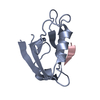
| ||||||||
| 2 | 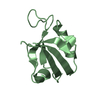
| ||||||||
| Unit cell |
|
- Components
Components
| #1: Protein | Mass: 11471.255 Da / Num. of mol.: 2 / Fragment: PDZ2 domain Source method: isolated from a genetically manipulated source Source: (gene. exp.)   #2: Protein/peptide | Mass: 1747.048 Da / Num. of mol.: 2 / Source method: obtained synthetically / Details: synthetic 18-mer peptide / References: GenBank: 29789269, UniProt: M0R9A7*PLUS #3: Water | ChemComp-HOH / | |
|---|
-Experimental details
-Experiment
| Experiment | Method:  X-RAY DIFFRACTION / Number of used crystals: 1 X-RAY DIFFRACTION / Number of used crystals: 1 |
|---|
- Sample preparation
Sample preparation
| Crystal | Density Matthews: 1.97 Å3/Da / Density % sol: 37.5 % |
|---|---|
| Crystal grow | Temperature: 293 K / Method: vapor diffusion, sitting drop / pH: 8.5 Details: 0.2M SODIUM ACETATE, 0.1M TRIS-HCL, 30% PEG 4000 , pH 8.5, VAPOR DIFFUSION, SITTING DROP, temperature 293K |
-Data collection
| Diffraction | Mean temperature: 100 K |
|---|---|
| Diffraction source | Source:  SYNCHROTRON / Site: SYNCHROTRON / Site:  ESRF ESRF  / Beamline: ID14-1 / Wavelength: 0.934 Å / Beamline: ID14-1 / Wavelength: 0.934 Å |
| Detector | Type: ADSC QUANTUM 4 / Detector: CCD / Date: Nov 8, 2004 |
| Radiation | Monochromator: DIAMOND (111) AND GE(220) / Protocol: SINGLE WAVELENGTH / Monochromatic (M) / Laue (L): M / Scattering type: x-ray |
| Radiation wavelength | Wavelength: 0.934 Å / Relative weight: 1 |
| Reflection | Resolution: 2.35→50 Å / Num. all: 8429 / Num. obs: 8429 / % possible obs: 97.5 % / Observed criterion σ(F): 0 / Observed criterion σ(I): 0 |
| Reflection shell | Resolution: 2.35→2.45 Å / % possible all: 96.6 |
- Processing
Processing
| Software |
| |||||||||||||||||||||||||||||||||||||||||||||||||||||||||||||||||||||||||||||||||||||
|---|---|---|---|---|---|---|---|---|---|---|---|---|---|---|---|---|---|---|---|---|---|---|---|---|---|---|---|---|---|---|---|---|---|---|---|---|---|---|---|---|---|---|---|---|---|---|---|---|---|---|---|---|---|---|---|---|---|---|---|---|---|---|---|---|---|---|---|---|---|---|---|---|---|---|---|---|---|---|---|---|---|---|---|---|---|---|
| Refinement | Method to determine structure:  MOLECULAR REPLACEMENT MOLECULAR REPLACEMENTStarting model: 1PDR Resolution: 2.35→38.63 Å / Cor.coef. Fo:Fc: 0.948 / Cor.coef. Fo:Fc free: 0.897 / SU B: 12.166 / SU ML: 0.276 / Cross valid method: THROUGHOUT / σ(F): 0 / ESU R: 0.383 / ESU R Free: 0.291 / Stereochemistry target values: MAXIMUM LIKELIHOOD / Details: HYDROGENS HAVE BEEN ADDED IN THE RIDING POSITIONS
| |||||||||||||||||||||||||||||||||||||||||||||||||||||||||||||||||||||||||||||||||||||
| Solvent computation | Ion probe radii: 0.8 Å / Shrinkage radii: 0.8 Å / VDW probe radii: 1.2 Å / Solvent model: MASK | |||||||||||||||||||||||||||||||||||||||||||||||||||||||||||||||||||||||||||||||||||||
| Displacement parameters | Biso mean: 45.075 Å2
| |||||||||||||||||||||||||||||||||||||||||||||||||||||||||||||||||||||||||||||||||||||
| Refinement step | Cycle: LAST / Resolution: 2.35→38.63 Å
| |||||||||||||||||||||||||||||||||||||||||||||||||||||||||||||||||||||||||||||||||||||
| Refine LS restraints |
| |||||||||||||||||||||||||||||||||||||||||||||||||||||||||||||||||||||||||||||||||||||
| LS refinement shell | Resolution: 2.353→2.414 Å / Total num. of bins used: 20
|
 Movie
Movie Controller
Controller


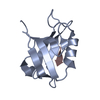


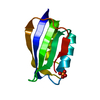
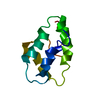

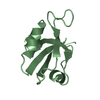

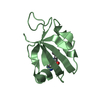

 PDBj
PDBj




